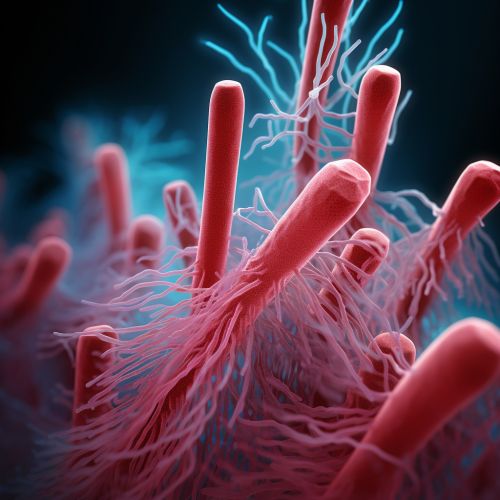Rod-shaped bacteria
Introduction
Rod-shaped bacteria, also known as bacilli, are one of the most common bacterial shapes, along with spherical (cocci) and spiral (spirilla) bacteria. They are characterized by their cylindrical or rod-like shape, which is typically several times longer than it is wide. This shape is thought to have evolved to maximize the surface area to volume ratio, allowing for efficient nutrient uptake and waste removal.
Morphology
The morphology of rod-shaped bacteria is diverse, with lengths typically ranging from 1 to 10 micrometers and diameters from 0.25 to 1.0 micrometers. The cell wall of these bacteria is composed of peptidoglycan, a complex polymer that provides structural support and protects the cell from osmotic pressure. The cell wall also contains lipopolysaccharides and proteins that play a role in the bacteria's interaction with its environment.


Classification
Rod-shaped bacteria can be classified based on their Gram staining characteristics, oxygen requirements, and metabolic capabilities. Gram-positive rod-shaped bacteria, such as Bacillus subtilis and Clostridium perfringens, have a thick peptidoglycan layer and stain purple in a Gram stain. Gram-negative rod-shaped bacteria, such as Escherichia coli and Pseudomonas aeruginosa, have a thin peptidoglycan layer and an outer membrane, and they stain red in a Gram stain.
Metabolism
Rod-shaped bacteria exhibit a wide range of metabolic capabilities. Some are autotrophs, obtaining carbon from inorganic sources, while others are heterotrophs, obtaining carbon from organic sources. Some rod-shaped bacteria are aerobes, requiring oxygen for their metabolism, while others are anaerobes, which do not require oxygen. Some anaerobic rod-shaped bacteria are even harmed by the presence of oxygen.
Pathogenicity
Some rod-shaped bacteria are pathogenic, causing diseases in humans and other animals. For example, Escherichia coli is a common cause of urinary tract infections and foodborne illnesses. Clostridium perfringens is a major cause of food poisoning, while Mycobacterium tuberculosis, another rod-shaped bacterium, causes tuberculosis.
Role in the Environment
Rod-shaped bacteria play a crucial role in various environmental processes. They are involved in nutrient cycling, decomposition of organic matter, and the maintenance of soil fertility. They also play a role in the production of certain foods and beverages through fermentation processes.
